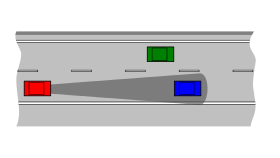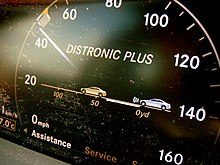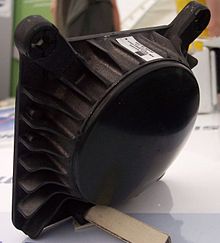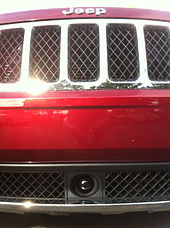用戶:某智的皮神/沙盒5

| 外部影片連結 | |
|---|---|
Adaptive cruise control (ACC) is an available cruise control advanced driver-assistance system for road vehicles that automatically adjusts the vehicle speed to maintain a safe distance from vehicles ahead. As of 2019, it is also called by 20 unique names that describe that basic functionality. This is also known as Dynamic cruise control.[1]
Control is based on sensor information from on-board sensors. Such systems may use a radar or laser sensor or a camera setup allowing the vehicle to brake when it detects the car is approaching another vehicle ahead, then accelerate when traffic allows it to. ACC technology is regarded as a key component of future generations of intelligent cars. The technology enhances passenger safety and convenience as well as increasing road capacity by maintaining optimal separation between vehicles and reducing driver errors. Vehicles with autonomous cruise control are considered a Level 1 autonomous car, as defined by SAE International.[2] When combined with another driver assist feature such as lane centering, the vehicle is considered a Level 2 autonomous car. Adaptive cruise control does not provide full autonomy: the system only provides some help to the driver, but does not drive the car by itself.[3]
== History ==


* 1992: Mitsubishi was the first to offer a lidar-based distance detection system on the Japanese market called Debonair. Marketed as "distance warning", this system warns the driver, without influencing throttle, brakes, or gearshifting.[4][5]* 1995: Mitsubishi Diamante introduced laser "Preview Distance Control". This system controlled speed through throttle control and downshifting, not by applying the brakes.[4][6]* 1997: Toyota offered a "laser adaptive cruise control" (lidar) system on the Japanese market Celsior.[7] It controlled speed through throttle control and downshifting, not by applying the brakes.* 1999: Mercedes introduced "Distronic", the first radar-assisted ACC[來源請求], on the Mercedes-Benz S-Class (W220)[8][9] and the CL-Class.[10]* 1999: Jaguar began offering a radar-based ACC system on the Jaguar XK (X100).[11]* 1999: Nissan introduced laser ACC on the Japanese market Nissan Cima.[12]* 1999: Subaru introduced world's first camera-based ACC on the Japanese-market Subaru Legacy Lancaster.[13]* 2000: BMW introduced radar "Active Cruise Control" in Europe on the BMW 7 Series - E38.[14]* 2000: Toyota was the first to bring laser ACC to the US market in late 2000, with the LS 430 Dynamic Laser Cruise Control system.[15]* 2000: Toyota's laser ACC system added "brake control", that also applies brakes.[7]* 2001: Infiniti introduced laser "Intelligent Cruise Control" on the 2002 Infiniti Q45 Third generation F50 and 2002 Infiniti QX4.* 2001: Renault introduced ACC on the Renault Vel Satis[16] (supplied by Bosch[17])* 2002: Lancia introduced radar ACC (by Bosch) on the Lancia Thesis[18]* 2002: Volkswagen introduced radar ACC, manufactured by Autocruise (now TRW), on the Volkswagen Phaeton.* 2002: Audi introduced radar ACC (Autocruise) on the Audi A8 in late 2002* 2003: Cadillac introduced radar ACC on the Cadillac XLR.[19]* 2003: Toyota shifted from laser to radar ACC on the Celsior.[7] The first Lexus Dynamic Radar Cruise Control and a radar-guided pre-collision system appeared on the Lexus LS (XF30) US market facelift.[20]* 2004: Toyota added "low-speed tracking mode" to the radar ACC on the Crown Majesta.[7] The low-speed speed tracking mode was a second mode that would warn the driver and provide braking if the car ahead stopped; it could stop the car, but would then deactivate.[21]* 2005: In the United States, Acura introduced radar ACC integrated with a Collision avoidance system (Collision Mitigation Braking System (CMBS)) in the model year 2006 Acura RL.[22]* 2005: Mercedes-Benz S-Class (W221) upgraded ACC to completely halt the car if necessary (now called "Distronic Plus" on E-Class and most Mercedes sedans.* 2006: Volkswagen Passat B6 introduced radar ACC supplied by Autocruise and TRW, functioning from 30至210 km/h(19至130 mph). It supported additional functions AWV1 and AWV2 to prevent collisions by using the brake system.* 2006: Audi introduced full speed range ACC plus on the Audi Q7. In low-speed mode, it warns the driver of a potential collision and prepares emergency braking as needed.[23] The system was supplied by Bosch.* 2006: Nissan introduced "Intelligent Cruise Control with Distance Control Assist" on Nissan Fuga.[24] It pushes the gas pedal against the foot when the navigation system observes an unsafe speed. If the Autonomous cruise control system is used, the Distance Control Assistance reduced speed automatically and warned the driver with an audible bell sound.* 2006: September 2006 Toyota introduced its "all-speed tracking function" for the Lexus LS 460.[7] The radar-assisted system maintained continuous control from speeds from 0至100 km/h(0至62 mph) and is designed to work under stop/go situations such as highway traffic congestion.[25]* 2007: BMW introduced full-speed Active Cruise Control Stop-and-Go on the BMW 5 Series (E60).[26]* 2008: Lincoln introduced radar ACC on the 2009 Lincoln MKS.* 2008: SsangYong Motor Company introduced radar "Active Cruise Control" on the SsangYong Chairman[27]* 2008: Volkswagen Passat CC, B6 and Touareg GP. The ACC system was updated to support a full auto stop and added Front Assist function to prevent collisions working separately of ACC. Front Assist cannot brake automatically, it only increases the pressure in the brake system and warns the driver.* 2008: Volkswagen Golf 6 introduced ACC with lidar.* 2009: Hyundai introduced radar ACC on Hyundai Equus in Korean market.* 2009: ACC and CMBS also became available as optional feature for the 2010 Acura MDX[28][與來源不符] Mid Model Change (MMC) and the newly introduced model year 2010 Acura ZDX.[29]*2010: Ford debuted its first ACC on the sixth generation Ford Taurus (option on most models, standard on the SHO)* 2010: Audi introduced a GPS-guided radar ACC on Audi A8#D4[30]* 2010: Volkswagen Passat B7, CC. Update of ACC and updated Front Assist. Introduced emergency braking, named "City". The car could brake automatically to prevent a collision.* 2010: Jeep introduced ACC on the 2011 Jeep Grand Cherokee[31]* 2012: Volkswagen made ACC standard on the Volkswagen Golf MK7 SE and above. * 2013: Mercedes introduced "Distronic Plus with Steering Assist" (traffic jam assist) on the Mercedes-Benz S-Class (W222)[32]* 2013: BMW introduced Active Cruise Control with Traffic Jam Assistant.[33]* 2014: Chrysler introduced full speed range radar "Adaptive Cruise Control with Stop+" on the 2015 Chrysler 200.* 2014: Tesla introduced autopilot feature to Model S cars, enabling semi-autonomous cruise control.[34][35][36]* 2015: Ford introduced the first pickup truck with ACC on the 2015 Ford F150.* 2015: Honda introduced its European CR-V 2015 with predictive cruise control.[37]*2015: Volvo began offering ACC on all its models.[38]* 2017: Cadillac introduced its Super Cruise semi-autonomous feature in the model year 2018 CT6 (for cars produced on or after 6 September 2017). The system used onboard radar and cameras along with lidar mapping data, allowing the driver to go hands-free on limited-access highways.* 2017: Toyota introduced its safety sense on all models as a standard feature. Toyota Safety Sense™ P (TSS-P) includes DRCC (dynamic radar cruise control) that uses a front-grille-mounted radar and a forward-facing camera that is designed to detect a vehicle in front and automatically adjust the vehicle's speed to help maintain a pre-set distance behind a vehicle ahead. == Types ==



SteeringSwitch (ProPilot)
Nissan Serena
Laser-based systems do not detect and track vehicles in adverse weather conditions nor do they reliably track dirty (and therefore non-reflective) vehicles. Laser-based sensors must be exposed, the sensor (a fairly large black box) is typically found in the lower grille, offset to one side. Radar-based sensors can be hidden behind plastic fascias; however, the fascias may look different from a vehicle without the feature. For example, Mercedes-Benz packages the radar behind the upper grille in the center and behind a solid plastic panel that has painted slats to simulate the look of the rest of the grille. Single radar systems are the most common. Systems involving multiple sensors use either two similar hardware sensors like the 2010 Audi A8[39] or the 2010 Volkswagen Touareg,[40] or one central long range radar coupled with two short radar sensors placed on the corners of the vehicle like the BMW 5 and 6 series.[41] A more recent development is the binocular computer vision system, such as that introduced to the US market in model year 2013 by Subaru. These systems have front-facing video cameras mounted on either side of the rearview mirror and use digital processing to extract depth information from the parallax between the two cameras' views. === Assisting systems ===Radar-based ACC is often sold together with a precrash system,[42] which warns the driver and/or provides brake support if there is a high risk of a collision. Also in certain cars, it is incorporated with a lane maintaining system which provides a power steering assist to reduce steering input burden on corners when the cruise control system is activated. === Multi-sensor systems ===Systems with multiple sensors can practice sensor fusion to integrate the data to improve safety and/or driving experience. GPS data can inform the system of geographic features such as a freeway offramp. A camera system could notice driver behavior such as brake lights and/or a turn signal. This could allow the following car to interpret a turn signal by an exit as not requiring the following car to slow down, as the leading car will exit.[30] Multi-sensor systems could also take note of traffic signs/signals and not, e.g., violate a red light while following a vehicle that crossed before the signal changed. === Predictive systems ===Predictive systems modify vehicle speed based on predictions of other vehicles' behavior. Such systems can make earlier, more moderate adjustments to the predicted behavior, improving safety and passenger comfort. One example is to predict the likelihood of a vehicle in a neighboring lane moving in front of the controlled vehicle. One system predicts a lane change up to five seconds before it occurs.[37] ==Regulations and norms==Adaptive cruise control is regulated by european norm ISO 15622 Intelligent transport systems — Adaptive cruise control systems — Performance requirements and test procedures.[43] According to this standard, an ACC is partial automation of longitudinal vehicle control to reduce theworkload of the driver on roads where non-motorized vehicles and pedestrians are prohibited. It does not deal with stationary objects.[44] According to this standard, ACC includes two classes of systems: the FSRA (full speed range) and the LSRA (limited speed range).[44]
== Vehicle models supporting adaptive cruise control ==
The three main categories of ACC are: * Vehicles with Full Speed Range 0MPH are able to bring the car to a full stop to 0 mph(0 km/h) and need to be re-activated to continue moving with something like a tap of the gas pedal.* Vehicles with Traffic Jam Assist / Stop & Go auto-resume from standstill to creep with stop and go traffic. * Vehicles with Partial cruise control cuts off and turns off below a set minimum speed, requiring driver intervention.* Vehicles with fully automated speed control can respond to traffic signals and non-vehicular on-road activity.
Discovery 3 and 4 can retrofit L320 system with custom mounting hardware[67] === Mercedes Distronic Plus ===In 1999, Mercedes introduced Distronic, the first radar-assisted adaptive system, on the Mercedes-Benz S-Class (W220)[8][86] and the CL-Class.[10] Distronic adjusts the vehicle speed automatically to the car in front in order to always maintain a safe distance to other cars on the road.
In 2005, Mercedes refined the system ("Distronic Plus") making the Mercedes-Benz S-Class (W221) the first car to receive the upgraded system. Distronic Plus could now completely halt the car if necessary on most sedans. In an episode of Top Gear, Jeremy Clarkson demonstrated the effectiveness of the system by coming to a complete halt from motorway speeds to a round-about and getting out, without touching the pedals.[87] In 2016, Mercedes introduced Active Brake Assist 4, the first emergency braking assistant with pedestrian recognition.[88] One crash caused by Distronic Plus dates to 2005, when German news magazine "Stern" was testing Mercedes' original Distronic system. During the test, the system did not always manage to brake in time.[89] Ulrich Mellinghoff, then Head of Safety, NVH, and Testing at the Mercedes-Benz Technology Centre, stated that some tests failed because the vehicle was tested in a metallic hall, which caused problems with radar. Later iterations received an upgraded radar and other sensors, which are not disrupted by a metallic environment.[89][90] In 2008, Mercedes conducted a study comparing the crash rates of Distronic Plus vehicles and vehicles without it, and concluded that those equipped with Distronic Plus have an around 20% lower crash rate.[91] == See also ==* Autonomous car* Cooperative Adaptive Cruise Control* IEEE Intelligent Transportation Systems Society* Intelligent car* Lane centering* Lane departure warning system* Precrash system
== References ==- ^ Domonoske, Camila. A Safety Feature By Any Other Name Can Really Be Confusing, AAA Finds. NPR.org. 25 January 2019 [25 January 2019].
- ^ Path to Autonomy: Self-Driving Car Levels 0 to 5 Explained. Car and Driver. 3 October 2017.
- ^ Here is everything you need to know about adaptive cruise control. digitaltrends.com. 25 September 2017.
- ^ 4.0 4.1 Pratyush Bhatia. Vehicle Technologies to Improve Performance and Safety (PDF). [2015-12-30]. (原始內容 (PDF)存檔於11 October 2003).
- ^ Company History. Mitsubishi Motors. [30 December 2014]. (原始內容存檔於30 December 2014).
- ^ Press Release - Mitsubishi Motors Corporation. mitsubishi-motors.com (新聞稿). [14 January 2017].
- ^ 7.0 7.1 7.2 7.3 7.4 Technical Development - Electronics Parts. toyota-global.com. [6 April 2015].
- ^ 8.0 8.1 Mercedes-Benz S-Class, W 220 series (1998 to 2005) (新聞稿).
- ^ Innovation as a tradition. 27 November 2014. (原始內容存檔於29 December 2014).
- ^ 10.0 10.1 Technical highlights of the CL-Class and its predecessor series (新聞稿).
- ^ Jaguar Teams with Delphi to Introduce Adaptive Cruise Control. prnewswire.com (新聞稿).
- ^ Nissan Research Center - On the Research Front Lines - Hideaki Inoue. nissan-global.com. [30 December 2014]. (原始內容存檔於30 December 2014).
- ^ Subaru Legacy Lancaster ADA specification (新聞稿). [6 May 2022].
- ^ Fahrwerkhandbuch. Springer-Verlag. 25 September 2013: 639. ISBN 9783658019921.
- ^ Finally! Adaptive Cruise Control Arrives in the USA. Ivsource.net. 2000-09-29 [2011-10-12]. (原始內容存檔於8 September 2008).
- ^ First drive: Renault gets Vel Satis-faction. 2002-09-27 [2015-01-19]. (原始內容存檔於30 December 2014).
- ^ Premiere auf dem Automobilsalon in Genf: Renault Vel Satis mit neuer Wischertechnik von Bosch. Robert Bosch. 2001-03-09 [2015-01-19]. (原始內容存檔於30 December 2014).
- ^ Launch of top-of-the-range Lancia Thesis is delayed further. Automotive News Europe. 2011-09-24 [2015-01-19].
- ^ Delphi's Adaptive Cruise Control Technology Featured on Cadillac XLR. prnewswire.com (新聞稿).
- ^ 430: Luxury or 'ultra luxury'.
- ^ Low Speed ACC Finally Hits the Market. Ivsource.net. [2011-10-12]. (原始內容存檔於22 February 2012).
- ^ 2006 Acura RL – Safety. Hondanews.com (新聞稿). 2005-08-17 [2011-10-12].
- ^ Distance Control: DCX and VW Offering Adaptive Cruise Control System with a Low-Speed Mode. marklines.com. 7 April 2006 [2015-12-30]. (原始內容存檔於30 December 2014).
- ^ Nissan - news cite press release. nissan-global.com (新聞稿). [30 December 2014]. (原始內容存檔於27 October 2011).
- ^ Toyota Cruise Control 互聯網檔案館的存檔,存檔日期7 December 2008.
- ^ Active Cruise Control with Stop & Go function on the BMW 5 Series Sedan. Bmw.com. 2008-06-17 [2011-10-12].
- ^ Ssangyong Motor. smotor.com (新聞稿).
- ^ Acura Media Newsroom – MDX – Releases. Hondanews.com (新聞稿). [2011-10-12].
- ^ New 2010 Acura ZDX Four-Door Sports Coupe Delivers Style, Performance, Luxury and Refinement. Hondanews.com (新聞稿). 2009-08-17 [2011-10-12]. (原始內容存檔於14 December 2009).
- ^ 30.0 30.1 The new Audi A8 – The sportiest sedan in the luxury class (新聞稿). [30 December 2014]. (原始內容存檔於31 December 2014).
- ^ Chrysler Group. All-new 2011 Jeep Grand Cherokee Earns 'Top Safety Pick' From the Insurance. prnewswire.com (新聞稿). 2 June 2010 [6 April 2015].
- ^ New assistance systems: The helpers in the background (新聞稿).
- ^ BMW – Sheer Driving Pleasure. bmw.com.
- ^ Riding shotgun in Tesla's fastest car ever. Engadget. [2014-10-10].
- ^ Tesla D is, as expected, an AWD Model S but new autopilot features surprise. AutoblogGreen. [2014-10-10].
- ^ White, Joseph B. Tesla Aims to Leapfrog Rivals. The Wall Street Journal. 2014-10-10 [2015-03-21].
- ^ 37.0 37.1 Ramsey, Jonathon. New Honda smart cruise control predicts other motorists' future idiocy. Autoblog. 4 January 2015 [2017-02-26].
- ^ 38.0 38.1 Volvo S60 Adaptive Cruise Control. Volvo.com. [2011-11-13]. (原始內容存檔於18 November 2011).
- ^ Bloch, Alexander. Die Technik-Highlights des neuen Audi A8. Auto-motor-und-sport.de. 2010-01-18 [2011-10-12] (德語).
- ^ Bloch, Alexander. Assistenzsysteme im Test: Sechs Modelle im Sicherheitsvergleich. Auto-motor-und-sport.de. 2011-02-09 [2011-10-12] (德語).
- ^ Bloch, Alexander. Abstandsregeltempomaten im Test: Mittelklasse-Autos. Auto-motor-und-sport.de. 2010-01-08 [2011-10-12] (德語).
- ^ What is adaptive cruise control, and how does it work?. extremetech.com. [2019-10-23].
- ^ Iso 15622.
- ^ 44.0 44.1 ISO 15622:2018 - Intelligent transport systems — Adaptive cruise control systems — Performance requirements and test procedures - third edition. 2018 [6 May 2022].
- ^ An Android App For Cruise Control Accessed 3 November 2011.
- ^ 2016 Acura ILX Owner's Manual (PDF). (原始內容 (PDF)存檔於18 January 2016).
- ^ 2017 RDX User Manual (PDF): 54. [2 December 2016].
- ^ Alfa Romeo Feature Availability (PDF).
- ^ The new Audi A8. [17 February 2010].
- ^ USA News Accessed 6 September 2013.
- ^ McKeegan, Noel. Towards autonomy: Driving the new BMW 5 Series. newatlas.com. 6 March 2017 [2017-03-09].
- ^ https://media.buick.com/content/media/us/en/buick/vehicles/regal/2016/_jcr_content/iconrow/textfile/file.res/16-PG-Buick-Regal-070715.pdf [裸網址]
- ^ IIHS Accessed 16 September 2016.
- ^ 2019 Chevy Equinox Gets New Colors, New Tech, and a Whole Lot More. 10 April 2018.
- ^ 2020 Chevrolet Silverado Gets the Adaptive Cruise It Should Have Had for 2019. 24 May 2019.
- ^ Chrysler - Build & Price Accessed 9 September 2014.
- ^ Compare Models. ford.com.au. [14 January 2017].
- ^ 10 Awesome Driver-Assist Features That Help 2015 Ford F-150 Customers Drive Smarter - Ford Media Center. ford.com (新聞稿). [14 January 2017].
- ^ 59.0 59.1 Ford Media Release:Adaptive Cruise Control and Collision Warning with Brake Support (PDF) (新聞稿). [19 July 2012]. (原始內容 (PDF)存檔於14 October 2013).
- ^ 2019 GMC Terrain Changes, Updates, New Features
- ^ Which cars have self driving features for 2018. cars.com. [25 July 2018].
- ^ Honda Cars - Sensing Technology. honda.com. [14 January 2017].
- ^ Honda Sensing. honda.com. [10 September 2015].
- ^ 2014 Jeep Cherokee Owner's Manual (PDF). (原始內容 (PDF)存檔於26 January 2017).
- ^ 2011 Jeep Grand Cherokee Owners Manual (PDF). [7 April 2013]. (原始內容 (PDF)存檔於26 January 2017).
- ^ ACC retrofit to MY12 4.4 TDV8 help. fullfatrr.com. [2021-03-17].
- ^ ACC (adaptive Cruise Control) Retrofit. disco3.co.uk. [2021-03-17].
- ^ All-New Lincoln Continental Delivers Quiet Luxury: Elegant, Serene, Effortlessly Powerful. media.lincoln.com (新聞稿). 2016 [16 March 2021].
- ^ Quiet Luxury: Intuitive Technology, Effortless Performance and Distinctive Design Drive 2017 Lincoln MKZ. media.lincoln.com (新聞稿). 2016 [16 March 2021].
- ^ Experience Amazing. lexus.com. [2021-03-04].
- ^ Experience Amazing. lexus.com. [2021-03-04].
- ^ 2017 Mazda CX-5 first drive review: Will more tech, quieter cockpit match Audi, BMW?. extremetech.com. [24 November 2017].
- ^ 2021 Mazda6: Standing Out from Its Class.
- ^ MAZDA MRCC - Active Safety Technology. mazda.com. [6 April 2015].
- ^ New SEAT Ateca – Car Safety. seat.com. [2016-10-06].
- ^ 2013 Subaru Legacy and Outback (PDF). subaru.com. [2012-04-06]. (原始內容 (PDF)存檔於17 April 2012).
- ^ Eyesight Technology. tomshardware.com. 10 April 2013.
- ^ Tesla Firmware 6.1 Update Introduces Traffic-Aware Cruise Control for Autopilot. autoevolution.com. 13 January 2015 [2015-01-13].
- ^ Toyota Introduces New 10th-Generation Corolla in Japan. Automobile.com. [2011-10-12].
- ^ Toyota Safety Sense (TSS) Applicability Chart (PDF). [2017-04-26].[永久失效連結]
- ^ Prius v brochure (PDF).
- ^ Highlander brochure (PDF).
- ^ Camry brochure (PDF).
- ^ 2016 RAV4 Brochure (PDF).
- ^ Dynamic Laser Cruise Contro. pressroom.toyota.com (新聞稿). [6 May 2022]. (原始內容存檔於20 June 2019).
- ^ Innovation as a tradition. 27 November 2014. (原始內容存檔於29 December 2014).
- ^ Clarkson, Jeremy, Radar Guided Cruise Control, 4 July 2009 [11 July 2017], (原始內容存檔於2021-12-13)
- ^ Daimler AG. Mercedes-Benz Trucks: Safety: New assistance systems: Active Brake Assist 4 emergency: braking assistant featuring pedestrian recognition and: Sideguard Assist. media.daimler.com (新聞稿). 2016 [11 July 2017] (en-EN).
- ^ 89.0 89.1 Mercedes S-Klasse: Panne bei Crash-Test. Stern. 16 November 2005 [11 July 2017] (de-DE).
- ^ Pedestrian protection: Not just a question of compliance with crash-test regulations for Mercedes-Benz. media.daimler.com (新聞稿). [11 July 2017].
- ^ Philips, T. Mercedes-Benz Accident Study Shows 20 Percent of Rear End Collisions Can Be Avoided With Distronic Plus and Brake Assist Plus. emercedesbenz.com. 10 June 2008 [11 July 2017]. (原始內容存檔於24 September 2015).
== External links ==*Cooperative Adaptive Cruise Control: Human Factors Analysis—Federal Highway Administration Template:Autonomous cars and enabling technologies

